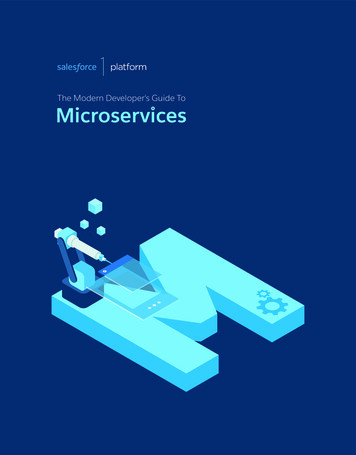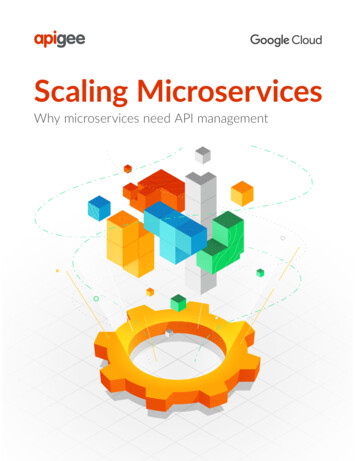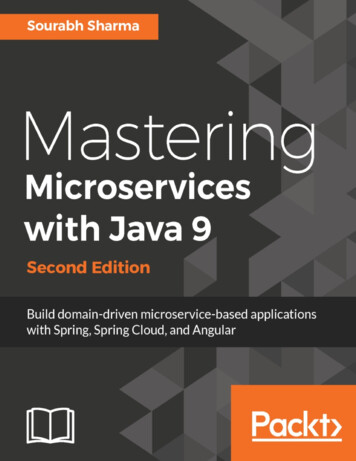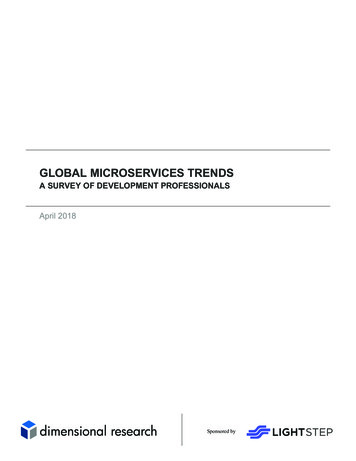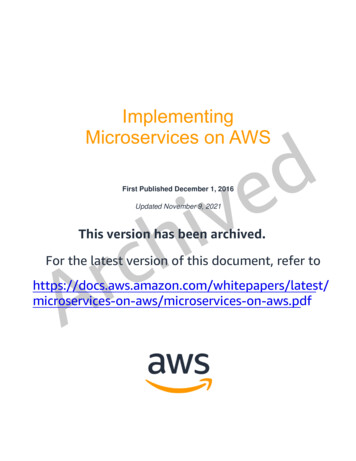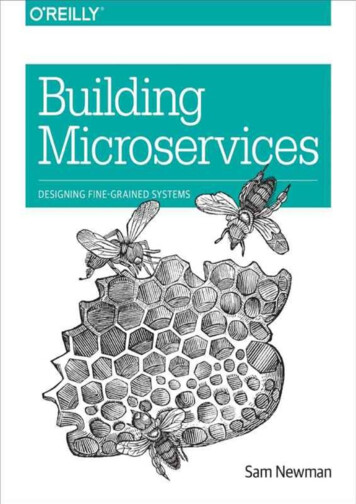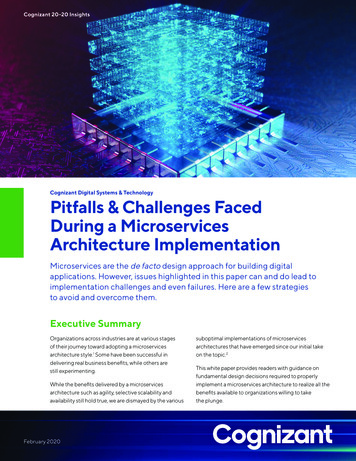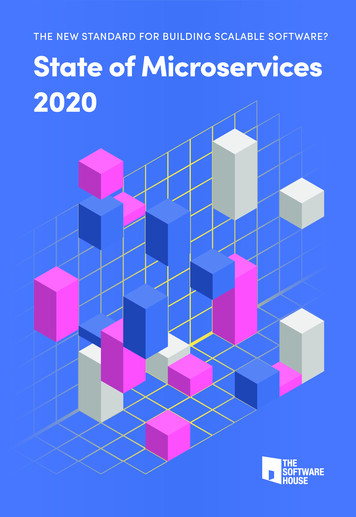
Transcription
MicroservicesS A U R A BH S R I VA STAVAD E PA R TM ENT OF C OM PU T E R S C I E N C E & E N G I N EE RI NGI I T K A N PU R
How do we buildSystems ?SAURABH SRIVASTAVA DEPARTMENT OF COMPUTER SCIENCE & ENGINEERING IIT KANPUR
We Have DataDataSAURABH SRIVASTAVA DEPARTMENT OF COMPUTER SCIENCE & ENGINEERING IIT KANPUR
ReadWe write codeto access that dataWriteDataRead/WriteSAURABH SRIVASTAVA DEPARTMENT OF COMPUTER SCIENCE & ENGINEERING IIT KANPUR
ReadWe then provideinterfaces to viewor edit this dataWriteDataRead/WriteSAURABH SRIVASTAVA DEPARTMENT OF COMPUTER SCIENCE & ENGINEERING IIT KANPUR
ReadWriteDataRead/WriteThis is a common way to build applications, since very longSAURABH SRIVASTAVA DEPARTMENT OF COMPUTER SCIENCE & ENGINEERING IIT KANPUR
The methodology is based on the 3-Tier ArchitectureSAURABH SRIVASTAVA DEPARTMENT OF COMPUTER SCIENCE & ENGINEERING IIT KANPUR
The methodology is based on the 3-Tier ArchitectureUserUI or Presentation LayerApplication or Business Logic LayerPersistence or Data LayerSAURABH SRIVASTAVA DEPARTMENT OF COMPUTER SCIENCE & ENGINEERING IIT KANPUR
The methodology is based on the 3-Tier ArchitectureUserUI or Presentation LayerCoinedaround2 decadesago !!Application or Business Logic LayerPersistence or Data LayerSAURABH SRIVASTAVA DEPARTMENT OF COMPUTER SCIENCE & ENGINEERING IIT KANPUR
The Monolithic SystemUI or Presentation LayerApplication or Business Logic LayerPersistence or Data LayerSAURABH SRIVASTAVA DEPARTMENT OF COMPUTER SCIENCE & ENGINEERING IIT KANPUR
Do we need a change inhow we build systems?SAURABH SRIVASTAVA DEPARTMENT OF COMPUTER SCIENCE & ENGINEERING IIT KANPUR
“If it ain't broke, don't fix it.”Bret Lance ‘1977SAURABH SRIVASTAVA DEPARTMENT OF COMPUTER SCIENCE & ENGINEERING IIT KANPUR
Do the Enterprises care to change if everything is well?SAURABH SRIVASTAVA DEPARTMENT OF COMPUTER SCIENCE & ENGINEERING IIT KANPUR
Do the Enterprises care to change if everything is well?Not really !!SAURABH SRIVASTAVA DEPARTMENT OF COMPUTER SCIENCE & ENGINEERING IIT KANPUR
Do the Enterprises care to change if everything is well?Not really !!So is everything well?SAURABH SRIVASTAVA DEPARTMENT OF COMPUTER SCIENCE & ENGINEERING IIT KANPUR
Do the Enterprises care to change if everything is well?Not really !!So is everything well?Not really !!SAURABH SRIVASTAVA DEPARTMENT OF COMPUTER SCIENCE & ENGINEERING IIT KANPUR
Do the Enterprises care to change if everything is well?Not really !!So is everything well?Not really !!So what’s wrong with current architectures?SAURABH SRIVASTAVA DEPARTMENT OF COMPUTER SCIENCE & ENGINEERING IIT KANPUR
Time to Market !!A typical enterprise software sees 2-6 releases a year That is about 2 months to release one version, at best !New Features must be thoroughly tested before they can go live Unit Tests, Integration Tests, Regression Tests, User Acceptance Tests The testing itself may take a month or more to completeContrast that to applications on the web Facebook makes changes to the live code on a daily basis [1] Even multiple releases a day, is fairly commonEnterprises would love to decrease the time it takes to release new versions The current architecture may involve rebuilding a lot of things – may be everything – for a small change Even if it doesn’t the coupling between the components may mandate regression testingSAURABH SRIVASTAVA DEPARTMENT OF COMPUTER SCIENCE & ENGINEERING IIT KANPUR
Operating on scale ?Internet is an utter chaos So much heterogeneity – from protocols to data formats to unreliable networks Yet some internet applications can somehow make it work, that too, on a large scaleEnterprise Solutions may need to go online (or may be already online) What if our systems are to be accessed by customers over the internet ? Can our monoliths handle the scale of internet?Scaling vertically is an option, or is it? We can add more hardware to our servers, and they can handle more load (vertical scaling) But what if the application is inherently incapable to use new cores (no parallelism) ?We can run multiple instances of the application Some parts of the application may be rarely used, but had to be replicated any wayCan’t we do better?SAURABH SRIVASTAVA DEPARTMENT OF COMPUTER SCIENCE & ENGINEERING IIT KANPUR
How about if we split the monolith ?SAURABH SRIVASTAVA DEPARTMENT OF COMPUTER SCIENCE & ENGINEERING IIT KANPUR
How about if we split the monolith ?Instead of one system, have a system of systemsSAURABH SRIVASTAVA DEPARTMENT OF COMPUTER SCIENCE & ENGINEERING IIT KANPUR
How about if we split the monolith ?Instead of one system, have a system of systemsEach smaller system, is a system on it’s ownSAURABH SRIVASTAVA DEPARTMENT OF COMPUTER SCIENCE & ENGINEERING IIT KANPUR
How about if we split the monolith ?Instead of one system, have a system of systemsEach smaller system, is a system on it’s ownIt keeps it’s own dataSAURABH SRIVASTAVA DEPARTMENT OF COMPUTER SCIENCE & ENGINEERING IIT KANPUR
How about if we split the monolith ?Instead of one system, have a system of systemsEach smaller system, is a system on it’s ownIt keeps it’s own dataProbably has it’s own UI tooSAURABH SRIVASTAVA DEPARTMENT OF COMPUTER SCIENCE & ENGINEERING IIT KANPUR
How about if we split the monolith ?Instead of one system, have a system of systemsEach smaller system, is a system on it’s ownIt keeps it’s own dataProbably has it’s own UI tooExposes an interface for others to useSAURABH SRIVASTAVA DEPARTMENT OF COMPUTER SCIENCE & ENGINEERING IIT KANPUR
The Monolithic SystemSAURABH SRIVASTAVA DEPARTMENT OF COMPUTER SCIENCE & ENGINEERING IIT KANPUR
The Monolithic SystemUI or Presentation LayerApplication or Business Logic LayerPersistence or Data LayerSAURABH SRIVASTAVA DEPARTMENT OF COMPUTER SCIENCE & ENGINEERING IIT KANPURRight nowwe are cutting ithorizontally
“Organizations which design systems . areconstrained to produce designs which arecopies of the communication structures ofthese organizations.”Conway’s Law ‘1968SAURABH SRIVASTAVA DEPARTMENT OF COMPUTER SCIENCE & ENGINEERING IIT KANPUR
The Monolithic SystemUI or Presentation LayerWe see itfrom atechnicalperspectiveApplication or Business Logic LayerPersistence or Data LayerSAURABH SRIVASTAVA DEPARTMENT OF COMPUTER SCIENCE & ENGINEERING IIT KANPURRight nowwe are cutting ithorizontally
The Monolithic SystemSAURABH SRIVASTAVA DEPARTMENT OF COMPUTER SCIENCE & ENGINEERING IIT KANPUR
The Monolithic SystemHow about if wecut itVertically ?SAURABH SRIVASTAVA DEPARTMENT OF COMPUTER SCIENCE & ENGINEERING IIT KANPUR
The Monolithic SystemServicesrepresent ervice#4SAURABH SRIVASTAVA DEPARTMENT OF COMPUTER SCIENCE & ENGINEERING IIT KANPURHow about if wecut itVertically ?
What are“Microservices” ?SAURABH SRIVASTAVA DEPARTMENT OF COMPUTER SCIENCE & ENGINEERING IIT KANPUR
Microservices areSmall, Autonomous services, that work together The smaller systems we talked aboutSAURABH SRIVASTAVA DEPARTMENT OF COMPUTER SCIENCE & ENGINEERING IIT KANPUR
Microservices areSmall, Autonomous services, that work together The smaller systems we talked aboutHow small is small? There’s no clear definition Lines of code is not very apt to calculate 100 lines of C code 100 lines of Python code Something that could be re-written in roughly two weeks time [2] Small enough, and no smaller [3]SAURABH SRIVASTAVA DEPARTMENT OF COMPUTER SCIENCE & ENGINEERING IIT KANPUR
Microservices areSmall, Autonomous services, that work together The smaller systems we talked aboutCapable to exist autonomously Shall be independently deployableIdeally on a separate hostAll communications to outside world are via network callsInterface to communicate should ideally be technology agnosticSAURABH SRIVASTAVA DEPARTMENT OF COMPUTER SCIENCE & ENGINEERING IIT KANPUR
What do we gain byusing Microservices ?SAURABH SRIVASTAVA DEPARTMENT OF COMPUTER SCIENCE & ENGINEERING IIT KANPUR
Technology HeterogeneitySometimes we choose technology that is the lowest common denominator Some things may be done better in some technologies A use-case may fit more to a NoSQL engine, than to an RDBMS engineThe learning curve for new technologies could be steep There may not be enough time for proper training of the staff It may be too risky to try them with little experienceThe interfaces may restrain our choices What if a component we need to talk only knows RMI? We are forced to use Java elsewhere too !SAURABH SRIVASTAVA DEPARTMENT OF COMPUTER SCIENCE & ENGINEERING IIT KANPUR
Technology HeterogeneitySince all the smaller systems are autonomous, they can be built using separate technologies As long as they conform to certain loose restrictions Like “being able to run on Linux” Lesser the restrictions, better it isIf we fail, we don’t lose much Since microservices are small in size, if we screw up, or realize that the technology change is adversarial,we still don’t lose much We can revert to old technology and rebuild the part from scratchLow risk, more scope to experiment We can pick up technologies that we think are better, to build one or few services at a time If they work, we can do the same with othersSAURABH SRIVASTAVA DEPARTMENT OF COMPUTER SCIENCE & ENGINEERING IIT KANPUR
ResilienceWhen something goes wrong in the monolith It can have a cascading effect One problem can bring down the whole systemMicroservices are isolated from each other If one service is down, the others may still keep going Supports the idea of graceful degradation much betterFault isolation and repair becomes easier The service that is down, needs to be looked into Smart logging can make it easier to find bugs, and repair them quicklySAURABH SRIVASTAVA DEPARTMENT OF COMPUTER SCIENCE & ENGINEERING IIT KANPUR
Ease of DeploymentIn monolithic systems, changes are not easy Every change may involve a complete re-build, and then a re-deployment The application most probably will be offline for this timeSo changes accumulate To avoid re-deployment, changes are accumulated till they become significant Higher the delta between releases, higher the riskSince all microservices are deployed independently Changes to one can be deployed without affecting others (changes which are not breaking changes) If the new release doesn’t work, a quick restore can be made to previous versionTime to market is reduced with microservices New changes can be rolled out easily, and with relatively lesser riskSAURABH SRIVASTAVA DEPARTMENT OF COMPUTER SCIENCE & ENGINEERING IIT KANPUR
Organizational AlignmentA small team is a happy team Smaller teams are generally more productive Reduces involvement of too many brains Better communication within the teamOne microservice can be owned by one team No external involvement, teams can be responsible for the full lifecycle of the service, includingoperation and maintenanceTeams can be built around business contexts rather than technology One team can cater to one business subdomain, via one or more microservices Can also interact directly with the customers to get better feedbackSAURABH SRIVASTAVA DEPARTMENT OF COMPUTER SCIENCE & ENGINEERING IIT KANPUR
Optimized for ReplacabilityBigger systems are hard to modernize or replace Building a newer version from scratch may involve too much effort, and riskMicroservices are optimized for replacement Since they are small, it is easier to write them from the scratch and replace For example, a custom made single-sign on service can be replaced by sign-in via Facebook easilySAURABH SRIVASTAVA DEPARTMENT OF COMPUTER SCIENCE & ENGINEERING IIT KANPUR
What’s the catch then inusing them ?SAURABH SRIVASTAVA DEPARTMENT OF COMPUTER SCIENCE & ENGINEERING IIT KANPUR
Not Magic WandsSo why don’t we all start using microservices? Just like any other Architectural Style, microservices have trade-offs Not everything associated with them make life easierSAURABH SRIVASTAVA DEPARTMENT OF COMPUTER SCIENCE & ENGINEERING IIT KANPUR
Not Magic WandsSo why don’t we all start using microservices? Just like any other Architectural Style, microservices have trade-offs Not everything associated with them make life easierNetwork Calls are slower Out-of-process call, like HTTP request is always slower than in-process call like method invocationNetworks can fail It may be difficult to figure out if a service is down, or is out-of-reachNetworks are insecure If the data travels over a network, say internet, it needs to be properly guarded against adversariesSAURABH SRIVASTAVA DEPARTMENT OF COMPUTER SCIENCE & ENGINEERING IIT KANPUR
Not Magic WandsSo why don’t we all start using microservices? Just like any other Architectural Style, microservices have trade-offs Not everything associated with them make life easierMore hosts to manage Typically each microservice runs on a different host A host could either be a physical machine, a virtual machine or even a docker container More microservices mean more hosts to manageSAURABH SRIVASTAVA DEPARTMENT OF COMPUTER SCIENCE & ENGINEERING IIT KANPUR
Not Magic WandsSo why don’t we all start using microservices? Just like any other Architectural Style, microservices have trade-offs Not everything associated with them make life easierDistributed Transactions With one database or process, transactions are easier to implement A rollback in case of failure is easy to achieve With multiple processes and database instances, each keeping track of some part of an overall businesstransaction, it is difficult to revert changes in case of failuresSAURABH SRIVASTAVA DEPARTMENT OF COMPUTER SCIENCE & ENGINEERING IIT KANPUR
Not Magic WandsSo why don’t we all start using microservices? Just like any other Architectural Style, microservices have trade-offs Not everything associated with them make life easierDistributed Monitoring and Logging Logging and monitoring one host is significantly simpler than a cluster of hosts Without automation, things can quickly become unmanageableSAURABH SRIVASTAVA DEPARTMENT OF COMPUTER SCIENCE & ENGINEERING IIT KANPUR
Modelling the system –business perspectiveSAURABH SRIVASTAVA DEPARTMENT OF COMPUTER SCIENCE & ENGINEERING IIT KANPUR
So we’ve decided to use the microservices styleSAURABH SRIVASTAVA DEPARTMENT OF COMPUTER SCIENCE & ENGINEERING IIT KANPUR
So we’ve decided to use the microservices styleWhere to start then?SAURABH SRIVASTAVA DEPARTMENT OF COMPUTER SCIENCE & ENGINEERING IIT KANPUR
So we’ve decided to use the microservices styleWhere to start then?Remember we talked about cutting vertically ?SAURABH SRIVASTAVA DEPARTMENT OF COMPUTER SCIENCE & ENGINEERING IIT KANPUR
So we’ve decided to use the microservices styleWhere to start then?Remember we talked about cutting vertically ?Ideally, one business task is represented by one serviceSAURABH SRIVASTAVA DEPARTMENT OF COMPUTER SCIENCE & ENGINEERING IIT KANPUR
So we’ve decided to use the microservices styleWhere to start then?Remember we talked about cutting vertically ?Ideally, one business task is represented by one serviceSo understanding the domain may be a good starting pointSAURABH SRIVASTAVA DEPARTMENT OF COMPUTER SCIENCE & ENGINEERING IIT KANPUR
So we’ve decided to use the microservices styleWhere to start then?Remember we talked about cutting vertically ?Ideally, one business task is represented by one serviceSo understanding the domain may be a good starting pointHow to model these business aspects?SAURABH SRIVASTAVA DEPARTMENT OF COMPUTER SCIENCE & ENGINEERING IIT KANPUR
Bounded ContextsWhat does a business comprise of ? Departments or sections For example, the Finance Department, the Store, the H.R. Department, the I.T. Department etc. A particular department, say Finance, may provide certain information to other departments, say I.T., viainterfaces The department may share some information with others, while at the same time, keep someinformation private with itself For example, the Finance Department may have an interface, by which I.T. Department can pull upselected finance data about an employee, and show it on an internal portalThese departments or sub-domains are known as Bounded Contexts A Bounded Context represents a specific set of responsibilities, guarded by certain boundaries Bounded Contexts themselves can be made up of smaller, sub-contextsSAURABH SRIVASTAVA DEPARTMENT OF COMPUTER SCIENCE & ENGINEERING IIT KANPUR
Bounded ContextsBounded Contexts have models Every Bounded Context have models associated with them For example, the H.R. Department may have a model that keeps information of an employee, storingdetails such as number of dependents, current grade, and leave balances The Finance Department will also have a model of an employee, storing details such as salary, dearnessallowance, savings declarations etc. The two departments may share a common aspect of the model, say Employee IdBounded Contexts share information via interfaces Imagine that the Finance Department needs to know about the unpaid leaves an employee took in thelast month The H.R. Department may expose an interface, which, on presenting with an Employee Id, may give outunpaid leave details Note that the H.R. Department may decide what aspects of the employee model to keep hidden, andwhat to exposeSAURABH SRIVASTAVA DEPARTMENT OF COMPUTER SCIENCE & ENGINEERING IIT KANPUR
Deciding Service BoundariesThe most tricky part in designing a microservice oriented system, is probably the choice ofservice boundaries Often we are tempted to choose boundaries that are technical and not business oriented Bounded Contexts can help A Bounded Context could be a good choice to draw service boundaryDon’t finalize the boundaries too soon It is extremely difficult to get the boundaries right in the first attempt One can make mistakes in doing so If you are unsure if a split makes sense or not, stay on the monolith side for some time – i.e. mergethese contexts (or don’t split them at first place) The more time one spends with the businesses, the more could be garnered about the BoundedContextsSAURABH SRIVASTAVA DEPARTMENT OF COMPUTER SCIENCE & ENGINEERING IIT KANPUR
Handling dependenciesIrrespective of how much we try to segregate our services, no service can exist in isolation Taking the example of Finance and H.R. Department, we may be tempted to keep one Employee Table inthe Database, keeping all the required information for both departments But the Employee Table is now a dependency for both Departments If a field needs to be added to the Employee table in future, who decides? In other words, who ownsthe Employee Table? The H.R. Department or the Finance Department?Database oriented dependencies are most common in monoliths Not a trivial job to break these dependencies May depend on case to case basis, what’s the best we can do?SAURABH SRIVASTAVA DEPARTMENT OF COMPUTER SCIENCE & ENGINEERING IIT KANPUR
Breaking Data Dependencies – An exampleSAURABH SRIVASTAVA DEPARTMENT OF COMPUTER SCIENCE & ENGINEERING IIT KANPUR
Breaking Data Dependencies – An RABH SRIVASTAVA DEPARTMENT OF COMPUTER SCIENCE & ENGINEERING IIT KANPUR
One possible way to draw service boundariesH.R.EmployeeTable(Complete) H.R. Service owns the Employee TableFinanceService BoundarySAURABH SRIVASTAVA DEPARTMENT OF COMPUTER SCIENCE & ENGINEERING IIT KANPUR
One possible way to draw service boundariesH.R.EmployeeTable(Complete) H.R. Service owns the Employee Table Finance Service makes an API call to theH.R. Service to get required InformationFinanceService BoundarySAURABH SRIVASTAVA DEPARTMENT OF COMPUTER SCIENCE & ENGINEERING IIT KANPUR
One possible way to draw service boundariesH.R.EmployeeTable(Complete) H.R. Service owns the Employee Table Finance Service makes an API call to theH.R. Service to get required Information Downside: H.R. Department is exposinginformation that doesn’t belong to itFinanceService BoundarySAURABH SRIVASTAVA DEPARTMENT OF COMPUTER SCIENCE & ENGINEERING IIT KANPUR
Another possible way to draw service leService BoundarySAURABH SRIVASTAVA DEPARTMENT OF COMPUTER SCIENCE & ENGINEERING IIT KANPUR
Another possible way to draw service boundariesH.R.EmployeeHRTable Each Service owns the data that belongsto itFinanceEmployeeFinTableService BoundarySAURABH SRIVASTAVA DEPARTMENT OF COMPUTER SCIENCE & ENGINEERING IIT KANPUR
Another possible way to draw service boundariesH.R.EmployeeHRTable Each Service owns the data that belongsto it They may still expose some dataFinanceEmployeeFinTableService BoundarySAURABH SRIVASTAVA DEPARTMENT OF COMPUTER SCIENCE & ENGINEERING IIT KANPUR
Another possible way to draw service boundariesH.R.EmployeeHRTable Each Service owns the data that belongsto it They may still expose some data Downside: Data update and sync issuesFinanceEmployeeFinTableService BoundarySAURABH SRIVASTAVA DEPARTMENT OF COMPUTER SCIENCE & ENGINEERING IIT KANPUR
Deploying and TestingMicroservicesSAURABH SRIVASTAVA DEPARTMENT OF COMPUTER SCIENCE & ENGINEERING IIT KANPUR
Let’s say we finalized one or more service boundariesSAURABH SRIVASTAVA DEPARTMENT OF COMPUTER SCIENCE & ENGINEERING IIT KANPUR
Let’s say we finalized one or more service boundariesAnd we found/formed teams willing to build themSAURABH SRIVASTAVA DEPARTMENT OF COMPUTER SCIENCE & ENGINEERING IIT KANPUR
Let’s say we finalized one or more service boundariesAnd we found/formed teams willing to build themAre we done then?SAURABH SRIVASTAVA DEPARTMENT OF COMPUTER SCIENCE & ENGINEERING IIT KANPUR
Let’s say we finalized one or more service boundariesAnd we found/formed teams willing to build themAre we done then?How will these services be deployed?SAURABH SRIVASTAVA DEPARTMENT OF COMPUTER SCIENCE & ENGINEERING IIT KANPUR
Let’s say we finalized one or more service boundariesAnd we found/formed teams willing to build themAre we done then?How will these services be deployed?How will they talk to each other?SAURABH SRIVASTAVA DEPARTMENT OF COMPUTER SCIENCE & ENGINEERING IIT KANPUR
Let’s say we finalized one or more service boundariesAnd we found/formed teams willing to build themAre we done then?How will these services be deployed?How will they talk to each other?How can we test them? In isolation and in action?SAURABH SRIVASTAVA DEPARTMENT OF COMPUTER SCIENCE & ENGINEERING IIT KANPUR
Continuous Integration and DeliveryGoal: Integrate different seams into one, and create an overall build of the product A concept independent of microservices, yet can be very helpful if adopted with themArtifacts: One or more artifacts are produced at the end of the Build Pipeline [6] A Test Suite is created, which is run in an automated fashion on the artifact(s)Red builds need to be fixed A Red Build is a build that failed to produce the artifact(s) it was supposed to In Continuous Integration / Continuous Delivery, a failed build is resolved at high priority Contrast that to a series of commits, coagulating in a repository, which is then built once a monthJenkins [7] and Bamboo [8] are two well known CI ToolsSAURABH SRIVASTAVA DEPARTMENT OF COMPUTER SCIENCE & ENGINEERING IIT KANPUR
ArtifactsArtifacts produced by Continuous Delivery may be technology specific Java has JAR and WAR filesRuby has GemsPython has EggsThe artifacts themselves may not be deployable directly We may have to use some level of automation, say Puppet Scripts, to put them in place The drawback here is if we allow such artifacts, we may end up having to manage multiple platforms tosupport each kind of artifactOperating System level artifacts One way to avoid this, is by using Operating System level artifacts For example, we may create an RPM file for RedHat or CentOS based systems, or a DEB package forUbuntu, or an MSI for Windows Downside: it is not that simple to find dependencies and create these artifact for multiple platformsSAURABH SRIVASTAVA DEPARTMENT OF COMPUTER SCIENCE & ENGINEERING IIT KANPUR
VM Images as artifactsOne way to deploy services, is via VM images Create a custom deployment image which can be spawned Typically, choose an operating system, say Ubuntu, install the tools required for running the service, sayApache and MySQL, and then save this base image in an Image Repository At the end of the Delivery Pipeline, an image is spawned, and the service is deployed on it Abstracts all the technologies, even the operating system in use A Virtual Machine player, like Virtualbox, can play the image, and we are done !Downside: No standardization ! An image made to run on AWS, won’t run on VMWare Building images for multiple platforms, in an automated fashion, is still not easyPacker [9] is a tool which can make our lives easier Supports building images for multiple platforms, from single source configurationSAURABH SRIVASTAVA DEPARTMENT OF COMPUTER SCIENCE & ENGINEERING IIT KANPUR
Testing the servicesUnit Tests Test functionalities local to a sub-system or microservice For instance, calls to certain methods, with expected returns lie in these categories Quite fast in general, several tests per minute can be runService Tests Test functionalities expected to be fulfilled by a serviceMay include tests to validate interfaces exposed by a service, e.g. the output formatFast enough generally, unless the Service needs to make downstream callsWe may need to mock behaviours for any downstream processesUI Tests or End-to-End Tests Cover cross-service aspects – generally one full use-caseSAURABH SRIVASTAVA DEPARTMENT OF COMPUTER SCIENCE & ENGINEERING IIT KANPUR
The Test PyramidUIServiceFasterBetter isolationUnitIncreasing scopeMore confidence As we move down, tests cover onlyspecific aspects of the system However, they are faster, and can helppin-point the problem If a test up in the pyramid passes, itgives more confidence about the overallwell-being of the systemMike Cohn.’s Test Pyramid [5]SAURABH SRIVASTAVA DEPARTMENT OF COMPUTER SCIENCE & ENGINEERING IIT KANPUR
Consumer driven testsServices are consumers as well as producers A service, in order to perform its tasks, may invoke other services Remember the H.R. and Finance example If we choose to use the first model, then the Finance service becomes a consumer of H.R. serviceConsumer-driven Contracts (CDCs) CDCs are formal expectations of a consumer, from a service [3] If captured fully, they can be baked into the CI build process of the producer If a release violates the contract, i.e. produce breaking changes, it never gets deployedTooling to help CDT Pact [11] is a tool developed originally at RealEstate.com.au which now supports Ruby, JVM and .Net forCustomer driven testingSAURABH SRIVASTAVA DEPARTMENT OF COMPUTER SCIENCE & ENGINEERING IIT KANPUR
Blue/Green DeploymentThe Blue/Green Deployment model is used in case we have little confidence over the newrelease After deploying a new instance of a service, do not direct production load on it straightawayRun a smoke test suite on the newer service instance(s)Detect any issues with deployment environmentAfter the tests succeed, allow production traffic on the new instanceDo keep the older ones alive for a while for any plausible rollbacksBe prepared for rollbacks If something goes wrong during the testing, or if the service doesn’t perform as per expectations, theolder version is rolled backCanary Releasing – a slight variant Keep both versions in production, for a longer time, and evaluate them side-by-side; complete roll-outhappens there is enough confidenceSAURABH SRIVASTAVA DEPARTMENT OF COMPUTER SCIENCE & ENGINEERING IIT KANPUR
“All successful applications have anarchitecture that sucks.”Stefan Tilkov ‘2014SAURABH SRIVASTAVA DEPARTMENT OF COMPUTER SCIENCE & ENGINEERING IIT KANPUR
Connectors for ComponentsArchitecture involves designing proper components, and proper connectors to connect them Connectors are as much bit important as the components Even the most sophisticated components may look like clowns, if they are connected with horribleconnectorsMicroservices bring with them, a problem Since services hear and respond over networks only, we are essentially choosing an unreliableconnector to connect our components Networks can fail, and will fail at some point of time – there is no way we can hide from this realitySo how do we integrate our services in this world? Build applications that are resilient to failures Expect failures, use failures as a part of the overall testing processSAURABH SRIVASTAVA DEPARTMENT OF COMPUTER SCIENCE & ENGINEERING IIT KANPUR
Synchronous vs Asynchronous CallsSynchronous Calls Service #1 calls Service #2 and blocks till it receives a response Simple to implement Results are known straightawayDownsides of Synchronous Communication What if Service #2 is down? There can be a Network outage insteadSAURABH SRIVASTAVA DEPARTMENT OF COMPUTER SCIENCE & ENGINEERING IIT KANPUR
Synchronous vs Asynchronous CallsAsynchronous Calls Service #1 requests Service #2 for a response Service #1 doesn’t wait for the response, but keep performing a periodic check to see if the responsehas arrived When it does, Service #1 processes the same More robust than waiting
Building a newer version from scratch may involve too much effort, and risk Microservices are optimized for replacement Since they are small, it is easier to write them from the scratch and replace For example, a custom made single-sign on service can be replaced by sign-in via Facebook easily
